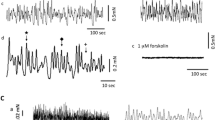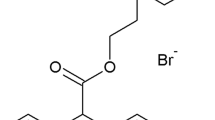Summary
This study was undertaken to determine dissociation constants (K A) and relative efficacies (e r) of seven muscarinic agonists (methylfurtrethonium; dioxolane, oxathiolane, carbachol, muscarine, muscarone and oxotremorine) in three isolated tissues (guinea-pig ileum and atria and rat urinary bladder).
The rank order of affinities (-log K A) of the various compounds varied depending on the tissue used. e r values for the different agonists did not differ significantly from each other in any of the three tissues, except that the e r of muscarine in the guinea-pig ileum was higher than those of the other compounds and that of oxotremorine in the rat urinary bladder was lower than those of the other agonists.
Comparisons among tissues show that K A and e r values were the same in different tissues for some compounds (muscarone, muscarine and methylfurtrethonium), while significant differences were found for the other compounds. This suggests the existence of a discrete receptor population recognized by some but not all agonists.
For oxotremorine er as well as -log K A, is greater in atria than in smooth muscle: these factors combine to determine the cardioselectivity of this compound which can now ascribed to receptor selectivity.
Similar content being viewed by others
References
Angeli P, Brasili L, Giannella M, Gualtieri P, Pigini M (1985) Affinity and efficacy correlate with chemical structure more than potency does in a series of pentatomic cyclic muscarinic agonists. Br J Pharmacol 85:783–786
Barlow RB, Berry KJ, Glenton PAM, Nikolaou NM, Seh KS (1976) A comparison of affinity constants for muscarnne-sensitive acetylcholine receptors in guinea-pig atrial pacemaker cells at 29°C and in ileum at 29°C and 37°C. Br J Pharmacol 58:613–620
Birdsall NJM, Burgen ASV, Hulme EC (1978) The binding of agonists to brain muscarinic receptors. Mol Pharmacol 14:723–736
Ehlert FJ, Roeske WR, Yamamura HI (1981) Muscarinic receptor: regulation by guanine nucleotides, ions and N-ethylmaleimide. Fed Proc 40:153–159
Fleming WW, Westfall DP, De La Lande IS, Jellet LB (1972) Lognormal distribution of equieffective doses of norepinephrine and acetylcholine in several tissues. J Pharmacol Exp Ther 181:339–345
Furchgott RF (1966) The use of β-haloalkylamines in the determination constants of receptor-agonist complexes. In: Harper NJ, Simmonds AB (eds) Advances in drug research, vol 3. Academic Press, London, pp 21–55
Furchgott RF, Bursztyn P (1967) Comparison of dissociation constants and of relative efficacies of selected agonists acting on parasympathetic receptors. Ann NY Acad Sci 144:882–899
Grana E, Lucchelli A, Zonta F, Santagostino-Barbone MG, D'Agostino G (1986) Comparative studies of the postjunctional activities of some very potent muscarinic agonists. Naunyn-Schmiedeberg's Arch Pharmacol 332:213–218
Kenakin TP (1983) Receptor classification by selective agonists: coping with circularity and circumstantial evidence. Trends Pharmacol Sci 4:291–295
Kenakin TP (1984) The relative contribution of affinity and efficacy to agonist activity: organ selectivity of noradrenaline and oxymetazoline with reference to the classification of drug receptors. Br J Pharmacol 81:131–141
Mitchelson F (1984) Heterogeneity in muscarinic receptors: evidence from pharmacologic studies with antagonists. Trends Pharmacol Sci Suppl:12–16
Mizushima A, Uchida S, Matsumoto K, Osugi T, Kagiya T, Zhou X, Higuchi H, Yoshida H (1985) Multiple agonist binding sites of muscarinic acetylcholine receptors and their relation to the negative inotropic action of agonists in guinea-pig heart. Eur J Pharmacol 119:177–182
Mutschler E, Lambrecht G (1984) Selective muscarinic agonists and antagonists in functional tests. Trends Pharmacol Sci Suppl: 39–44
Sokal RR, Rohlf FJ (1981) Biometry. Freemen, S. Francisco, p 240
Thron CD (1970) Graphical and weighted regression analyses for the determination of agonist dissociation constants. J Pharmacol Exp Ther 175:541–553
Yoshida H, Takeyasu K, Uchida S (1979) Muscarinic acetylcholine receptor and smooth muscle contraction. Trends Pharmacol Sci 1:2–4
Zaborowsky BR, McMahan WC, Griffin WA, Norris FH, Ruffole RR Jr (1980) Computerized graphic methods for determining dissociation constants of agonists, partial agonists and competitive antagonists in isolated smooth muscle preparations. J Pharmacol Meth 4:155–178
Author information
Authors and Affiliations
Additional information
Send offprint requests to E. Grana at the above address
Rights and permissions
About this article
Cite this article
Grana, E., Lucchelli, A., Zonta, F. et al. Determination of dissociation constants and relative efficacies of some potent muscarinic agonists at postjunctional muscarinic receptors. Naunyn-Schmiedeberg's Arch Pharmacol 335, 8–11 (1987). https://doi.org/10.1007/BF00165028
Received:
Accepted:
Issue Date:
DOI: https://doi.org/10.1007/BF00165028




